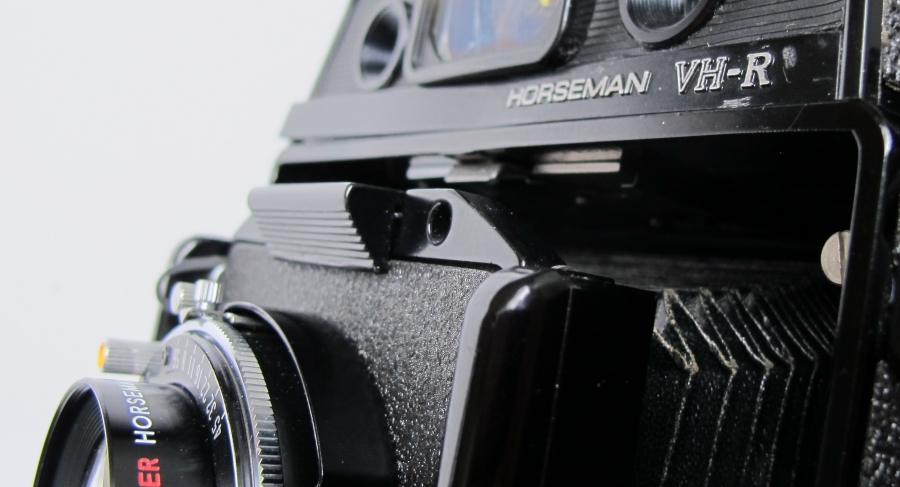
Horseman VH-R
6x9 Press Camera.
By Jo Lommen

Japanese Professional Press and Studio Camera
Characteristic looking medium format press
camera showing its bright viewfinder between the two rangefinder windows on top
of the 6x9 housing.
This double extension bellows camera with interchangeable
lenses was produced by the Komamura Corporation
established in 1947.
The company has been an important player in the international
professional camera business for more than 60 years.
Komamura Corporation developed and
marketed the Horseman Professional Cameras product range for medium and large format film.
In General
The Horseman VH-R is a Japanese look-a-like of
the American Press camera of the fifties and sixties of the last century
such as the
Graflex,
Busch,
Beseler,
Burke & James and
the British MPP.
Characteristic of these cameras was the drop bed, which in closed position also
serves as a camera door.
When the front door of the camera is in open position
you see the focusing track and rail guide.
The lens standard and bellows are
still folded safely inside in the back of the camera house.
The inside of the door now serves as a gangway for the
rail guide, focusing track and lens
standard.
The standard can be
drawn out of the housing by squeezing both front standard locks together while
pulling out the standard over the focusing track firmly against both of the infinity stops.
These infinity
stops have a pop up hinged stop.
Depending on which stop has been set, the
standard will stop and will be focused automatically on infinity for the
particular lens.
Unlike the other press cameras there are more than the usual two or four infinity stops.
The Horseman camera VH-R is standard equipped
with 5 pairs of them which can be used for 5 different lenses.
From the back to
the front we see a pair of white ones followed by red, green, yellow and finally
orange.
The white stop should couple the 75 mm lens, the red stop 105 mm and 90
mm and so on. Each lens has it own cam.
The cams are marked with the corresponding lenses and the colour
indicates the infinity stops to be used with them.
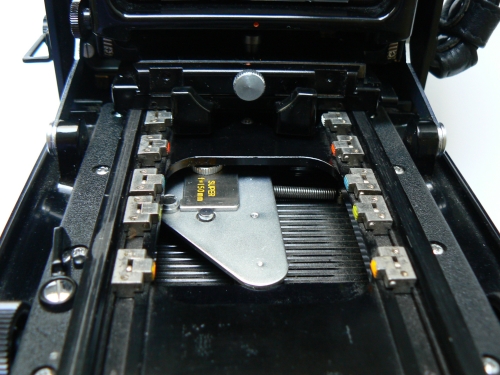
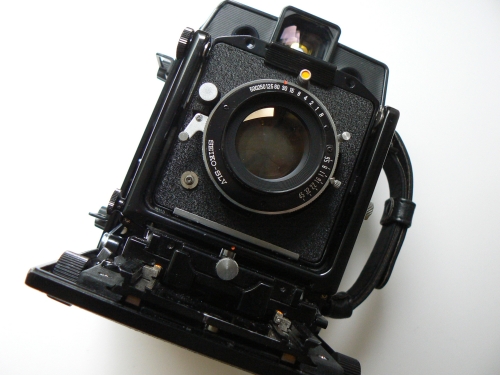
The Horseman Lenses
In order to couple the rangefinder, the cam,
lens and infinity stops must be used in a set.
That means: orange150 mm cam, orange
infinity-stop
set upwards as a constant reference to the infinity distance and orange cocking-lever on
150 mm lens.
The camera is now ready
for focusing on infinity or nearby distances by the use of the focusing knobs at
the front of the drop bed.
All lenses are mounted
in the Horseman 4 way lensboard measuring 80x80 mm which is exclusively prepared
and equiped with a safety lock.
There are several lenses
available for use with this exclusive camera:
| Lens | Cam Colour- Infinity stops | |
| Wide Angle | Super Horseman ƒ = 7 65 mm | White |
| Professional Horseman ƒ=5,6 75 mm | White | |
| Standard | Super Horseman ƒ= 5,6 90 mm | Red |
| Prof Horseman ƒ = 3,5 105 mm | Red | |
| Professional Horsem ƒ = 4,5 105 mm | Blue | |
| Super Horseman ƒ 5,6 120 mm | Green | |
| Telephoto | Super Horseman ƒ= 5,6 180 mm | Green |
| Long focal | Super Horseman ƒ = 5,6 150 mm | Orange |
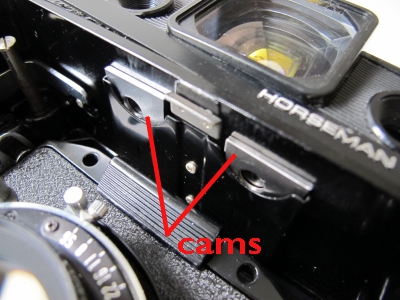
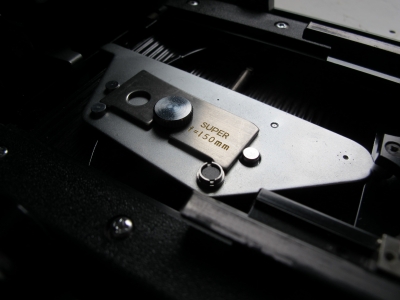
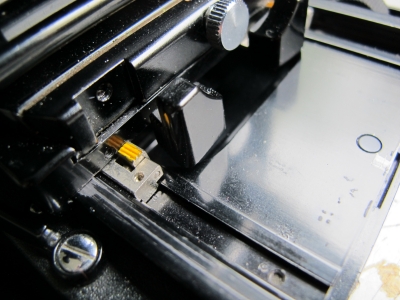

From left to right: Cam storage slot for 2 cams,
cam in position and
lensboard
placed against infinity stops.
If orange/yellow cam has been mounted - the 150 mm yellow dotted shutter
should be fitted which is visible
on shutter cocking lever lang="nl">- and
lens standard has to to be drawn against orange infinity stops.
The Horseman Camera.
Many desirable features.
The body section
Revolving back for portrait or landscape mode.
Revolving viewfinder frame for
landscape and portrait and an automatic revolving all viewfinder frame
parallax compensation mechanism which can also be used with wide angle lenses.
The camera body is finished in a black hard coat layer applied over a basic
construction of light alloy die cast.
The camera body contains the finder and the
lens standard mechanism.
The finder section on top of the camera house contains
the rangefinder and viewfinder.
The viewfinder can be turned in landscape or
portrait mode or any position in between matching the position of the revolving
back.
Parallax correction is automatically achieved when focusing.
The lens
board is sturdily built and it features a reinforced design to safeguard against
distortion and reflection.
The important camera bed extension mechanism which is
made up of the focusing track and rail guide features an oil-less finish which
is specially processed.
In order for the camera bed to be opened 90° or 105°
from the camera body and for it to be secured, the bed braces are L- shaped for
easy movement when wide angle lenses are being used.
There are two focusing
knobs at each end of the camera bed and a focusing lock is provided at the left.
The whole of the camera bed serves as a front cover for the camera and the
focusing knobs double as a mechanism that locks the front cover.
Tilt, swing,
shift and slide lens movements have been provided to make the camera suitable
for studio or architecture work.
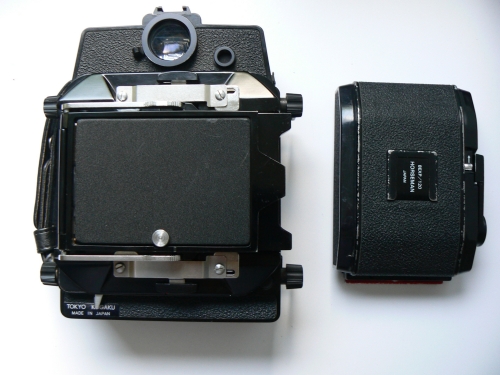
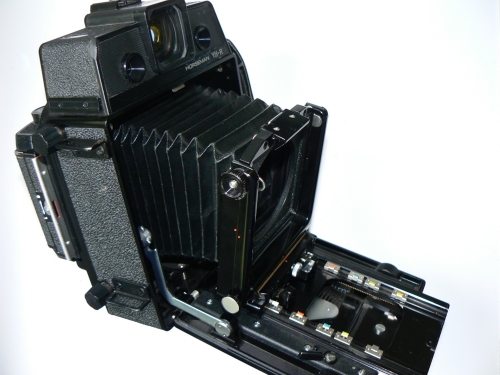
Revolving back with ground glass and viewing hood. On the right camera in drop bed mode for use with wide angle.
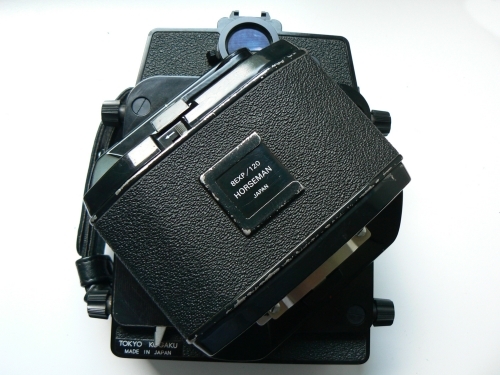
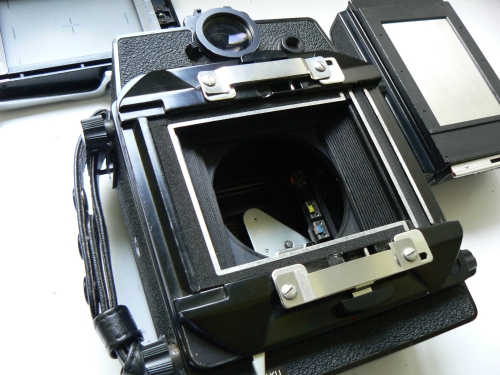
Revolving back with roll film holder mounted and on the right the open back ready to mount the 6x9 film holder or the ground glass assembly.
The finder section
The rangefinder magnification is 1:1.
The big
bright viewfinder framing 90-105-150 and 180 mm lenses can be turned freely
either horizontally in landscape as well as vertically in portrait mode
to match
the revolving back while parallax is automatically corrected with all of the
Horseman lenses.
All together a great feature.
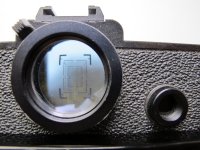
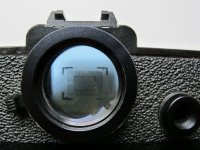
Bright view through the view finder.
The big eyepiece allows
you to focus with both eyes open.
The smaller eyepiece of the rangefinder which
is coupled to the focussing mechanics offers you a bright image to focus.
Lens Board section.
The 4x4 cm lens board is designed for easy but
safe mounting into the U shaped lens standard.
Lens changing is a matter of
seconds and it will fit in all 4 ways.
The U shaped lens standard itself looks
very sturdy and feels very dependable when sliding it over the rails setting it
in its demanded position.
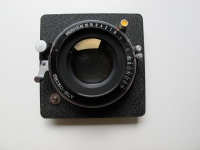
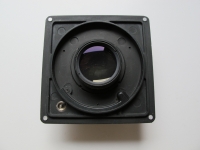
Rangefinder adjustment.
Make sure that the rangefinder cam
matches with the lens and is placed inside the
Rangefinder drop bed guide post.

To interchange cam
If lens is changed the cam should be changed as well and it should match with
the focal length of the lens.
Yellow engraving infinity stop is yellow dotted lens!
1) Push the lens standard all the way into the body.
2)Extend the focusing track by turning the focusing knob until the cam in the
bed is completely exposed.
3) Loosen the screw and slide out the cam that should be there.
If there is no cam you should find one, because without cam, the rangefinder
would not work at all.
4) Slide the replacement cam into position with the engraving marks up
5) Push the lower part of the cam first in, against the spring tensioned guide
post.
6) with the cam snugly in position all the way in, tighten the locking screw.
When lenses are interchanged the cams must also be interchanged.
Without its proper cams placed, a lens will not work in coupled action with the
rangefinder.
7) slide the focusing track back into the camera body by turning the focusing
knob
and raise up the correct infinity stop matching the lens to be used.
Trouble!
My images are out of focus
What's wrong?
If your exposures are out of focus and they
have been taken with the help of the rangefinder, there could be a problem with
the rangefinder.
If both
rangefinder images are visible but if they do not coincide you may try to solve this problem by placing the camera
on a tripod.
Aim the camera on a far away object by turning
the focusing knob until the track is back into the housing.
If you followed the previous installing advices the distance is
set automatically on infinity. when turning the focus knobs all the way back.
Check the image on the ground glass with wide open front lens on T and as
said, diaphragm wide open.
The ground glass image of a far away subject should be needle
sharp. Check the image on the ground glass with a magnifier.
If the image is not sharp than take care of that first by checking if the infinity stops are
corresponding with the lens and cam.
If the rangefinder is off
or is not working at all.
Repair suggestions
My camera came with four cams: 90, 105,
190 and 150 mm.
Unfortunately with no lens, but I was lucky to find an
original and mint Super Horseman 150 mm in Seiko SLV shutter.
Having the camera
complete then I wanted to go off and take photos with it.
Once the lens was mounted I found out
that the rangefinder was out of focus.
The distance needle in the top of the
rangefinder house was out of range and the rangefinder itself as well.
The
double image didn't move at all when turning the focusing knobs.
Despite close
inspection of the camera-house and drop-bed there was no sign of
adjusting screws or any thing that could be used to adjust the rangefinder.
The
only thing that obviously was part of some adjustment could be found inside the
camera house on the bottom of the left side seen from the front.
I found no way
to get a closer look of it to see the working without having to dismantle the
camera completely.
After
hours and hours I gave up searching.
The internet wasn't helpful either and I
placed the camera on the shelf and decided to get back to it at due time.
I use
to do this very often to give myself the opportunity to relax and wait for
inspiration.
After all, the factory workers who did assemble the camera, surely
had to adjust the rangefinder as being the last handling.
So there must be a
hidden "something".
A couple of days later I grabbed the camera from
the shelf and felt with my fingers along the leatherette on top, front and back
and along the rangefinder housing.
On the back of the lower part on the right
side of the top housing, seen from the back, I felt an irregularity.
Carefully I peeled off the leatherette and
found the hole from which the adjusting screw could be set.
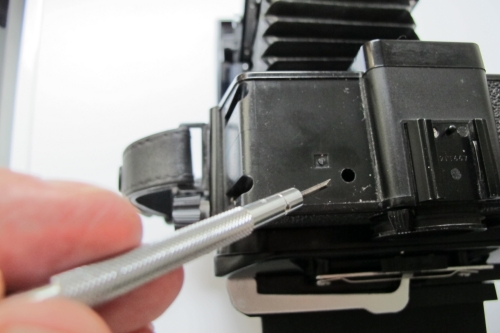
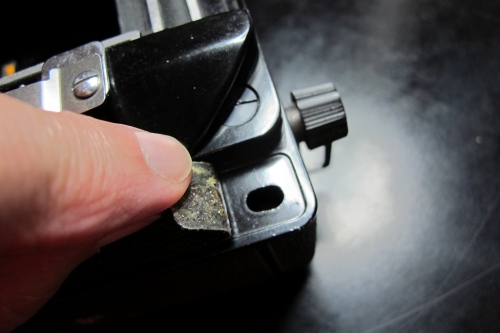
Photo left: Hidden under the leather on the
left top side of camera, this hole gives access to the vertical adjustment.
A long good fitting screwdriver is needed to search carefully for the adjustment
screw.
Photo below shows the inner part of the camera top rangefinder housing inside.
On both sides of the rangefinder housing you
find two screws that holds the top cover to the camera house.
The top cover hides the fine and vulnerable rangefinder mechanism including the
prism and the mirror.
So if it is not necessary, it would be wise not to take the cover off.
The hole shown on the left photo gives access to the parallax adjusting screw I mentioned
before.
This is the screw to adjust the infinity position of the distance scale
on top of the camera.
To work on this you first have to place the camera on a sturdy tripod.
Always make sure to have the single leg pointing in the same direction as the
lens. It prevents that you would stumble over this leg.
Do not underestimate this advice. These cameras are too heavy for use with a
cheap, thin and lightweight tripod.
Turn the focusing knob backwards as far as possible. Check lens and matching
coloured cam and infinity stops on the drop bed.
This is the infinity setting. Aim the camera on a far away object like a high
building.
The peep hole window on the right side from the centre window should show the
rangefinder adjustment.
One or two images are visible. If there is one image visible, the rangefinder is
calibrated just fine.
No further action is necessary.
However, if you can see two images the rangefinder is off focus and should be
calibrated.
Calibrating the rangefinder.
Now we have come to the rangefinder itself.
If
the two images of the far away subject in the rangefinder do not coinside than
turn the screw next to the round window very, very carefully until both
horizontal images coinside.
This can also be achieved by turning the screw using the hole in the top cover.
If the images do not coincide vertically, than adjust it with the
vertical axis adjustment screw as shown on photo below.
Horizontal alignment can be obtained by turning the infinity adjustment
screw as shown below.
This also can be achieved through the hole in the top cover which makes it a bit
easier.

For better understanding: photo shows the adjusting screws inside the
top camera housing.
Having done that successfully you may correct
the vertical coincide by inserting a fitting screwdriver inside the hole on top
of the rangefinder.
Try to find the adjusting screw by the feeling and when
found it turn it clockwise.
If the difference between both images is getting
wider than turn it anticlockwise until the images coinside.
Fix the leatherette
and enjoy working with this amazing camera.